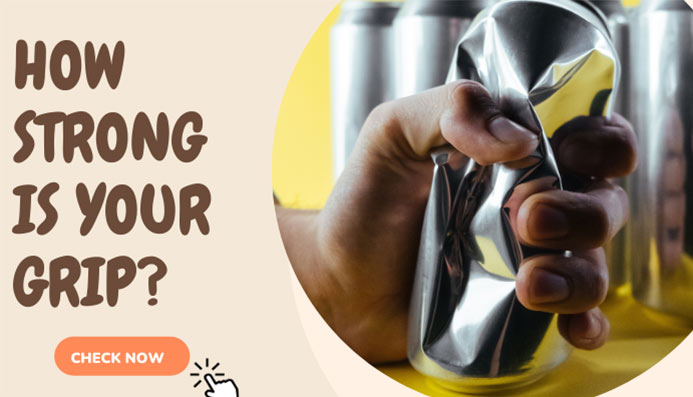Average grip strength: There are a few things that you should know about grip strength. For one, it is about 65% genetic. That means that if your parents or grandparents had strong hands, chances are that you will too. However, this does not mean that you cannot train your grip to be even stronger. But first let’s check out, whether you inherited good grip strength genetics or not. By comparing your grip strength to an average individual of your age group, and after the test you can get an estimate on how your grip strength can be improved. Generally, the grip strength increases up to 30% before grip strengthening exercises.
Average Male Grip Strength
Assuming you are using a standard grip strength test where the person squeezes a hand-held device as hard as possible, the average grip strength for a man between the ages of 20 and 39 would be right-handed – 100 to 144 pounds, and for left-handed – 82 to 136 pounds.
These numbers will vary depending on the individual’s height, weight, muscle mass, etc. This difference in grip strength can be attributed to the fact that most people are right-handed. Over time, the muscles in the right hand develop more power and strength than those in the left hand.
You May Also Like: What does decline bench work?
Average Female Grip Strength
The average grip strength for a female between the ages of 20 and 39 is 55 to 84 pounds for the right hand and 47 to 78 pounds for the left hand.
Many factors can affect grip strength, including age, health, and activity level. Generally, grip strength will peak in the late 20s or early 30s and then begin to decline. However, if a woman is healthy and active, she can maintain her grip strength into her 40s and beyond.
There are many ways to improve grip strength, such as lifting weights or doing exercises that target the muscles in the hands and wrists. Additionally, eating a healthy diet and maintaining a good level of fitness will help to keep grip strength high.
You May Also Like: 30 or 45-Degree Incline Bench
Average Grip Strength By Age
As we age, our grip strength begins to decline. This is due to several factors, including the loss of muscle mass and the deterioration of the connective tissues.
Researchers from the University of Wisconsin-Milwaukee collected data on more than 600 participants and published these grip strength norms in March 1985 for physical medicine and rehabilitation. These norms are widely used because they were developed and published before there was any large-scale research conducted on how much grip strength is necessary for a strong recovery.
The data is categorized into different age categories, ranging from age 20 to 74, for both males and females.
Check out whether your grip strength is standard in correspondence to your age:
Average Grip Strength For Males By Age
| AGE (MALES) | RIGHT HAND(KG) | LEFT HAND(KG) |
| 13-15 | 28.4 | 27.4 |
| 16-18 | 35.6 | 32.6 |
| 19-21 | 42.1 | 40 |
| 22-25 | 44.3 | 41.6 |
| 26-30 | 44.5 | 43.1 |
| 31-35 | 46.1 | 44.5 |
| 36-40 | 50.7 | 46.9 |
| 41-45 | 48.8 | 47.4 |
| 46-50 | 46.2 | 46.1 |
| 51-55 | 42.6 | 43.5 |
| 56-60 | 39.5 | 39.1 |
| 61-65 | 35.3 | 32.5 |
| 66-70 | 32.1 | 31.6 |
| 71-75 | 30.6 | 29 |
| 76+ | 28.6 | 21.4 |
Average Grip Strength For Females By Age
| AGE (FEMALES) | RIGHT HAND (KG) | LEFT HAND (KG) |
| 13-15 | 18.2 | 17.6 |
| 16-18 | 22.1 | 21.6 |
| 19-21 | 33 | 31 |
| 22-25 | 35 | 34.6 |
| 26-30 | 36 | 35.8 |
| 31-35 | 37 | 36.4 |
| 36-40 | 39 | 38.9 |
| 41-45 | 36 | 35 |
| 46-50 | 35 | 34 |
| 51-55 | 32 | 31.5 |
| 56-60 | 29 | 28.3 |
| 61-65 | 24 | 22 |
| 66-70 | 21 | 19 |
| 71-75 | 18 | 17 |
| 76+ | 14 | 12 |
Does Grip Strength Increase With Age?
Yes, according to research, grip strength does increase with age. A study published in the Journal of Strength and Conditioning Research found that grip strength increases with age in both men and women. The study participants were aged 18-88 years old, and the average grip strength for men was 36.6 kg and for women was 23.4 kg.
The study found that grip strength increased with age in both men and women, but the rate of increase was higher in men than in women. The study also found that there is a decline in grip strength after the age of 60 years old in both sexes, but again, the decline is greater in men than in women.
The study’s authors suggest that the increases in grip strength are due to the accumulation of years of muscle-building activity. They also note that the increases in grip strength may help to offset some of the age-related declines in other physical abilities.
So if you’re wondering whether you should start working on your grip strength as you get older, the answer is yes!
You May Also Like: Average Neck Size For Male And Female
Does Wrist Size Affect Grip Strength?
There are a few different ways that wrist size can affect grip strength. First, if you have small wrists, you may not be able to generate as much force when gripping an object. This is because the smaller the circumference of your wrist, the less surface area there is for your muscles to work with.
This can make it more difficult to grip and hold onto objects, which can in turn lead to reduced strength levels. Another way that small wrists can impact grip strength is by affecting your range of motion.
When your wrists are smaller, it can be more difficult to fully extend your fingers and thumbs, which can limit the amount of force you’re able to generate when gripping something.
You May Also Like: Average Leg Press For Male And Female
This reduced range of motion can also make it more difficult to perform certain tasks that require a strong grip, such as opening a jar or turning a doorknob.
Also, smaller muscles mean weaker muscles, and this is especially true in the case of the muscles in your wrists and hands. This can lead to reduced grip strength, which can be a major hindrance in activities that require strong hand grip, such as weightlifting, and rock climbing.
If you have small wrists and hands, there are still plenty of ways to improve your grip strength.
However, it’s important to be aware of the potential limitations that your wrist size may impose. By understanding how your wrist size can affect your grip strength, you can take steps to compensate for these limitations and still maintain a strong grip.
You May Also Like: Average Wrist Size For Male and Female
Does finger length affect grip strength?
Yes, finger length has a direct impact on grip strength, as according to the research conducted, athletes with longer fingers and greater hand surfaces also have greater grip strength. Thus, if you have longer fingers, then you have greater grip strength. However, genetics play a huge role in grip strength.
You May Also Like: Average Jump Height For Men And Women
Does a bigger hand size mean greater grip strength?
Yes, Yes, grip strength is directly proportional to hand size. The bigger your hand, the more grip strength you’ll have. After all, it stands to reason that if someone has larger hands, they would be able to apply more pressure and force than someone with smaller hands. Interestingly enough, this belief is supported by science.
A study published in the Journal of Hand Therapy looked at the correlation between hand size and grip strength. The study found that there was a direct correlation between the two variables, with larger hand size leading to more grip strength.
However, many factors contribute to grip strength, including the type of grip (e.g. pinch grip, power grip), the size of the object being held, and the amount of force applied. For example, someone with small hands may be able to hold a heavy object more securely than someone with large hands because they can apply more force.
You May Also Like: Average Head Size For Male And Female
How much can you increase grip strength?
A person’s grip strength is determined by a combination of factors, with genetics playing the largest role. Studies have shown that grip strength is about 65% genetic and 35% determined by training.
This means that, while training can certainly play a role in improving grip strength, there are limits to how much an individual can improve. It’s important to note that grip strength is not just a function of the muscles in the hands and arms. The tendons, joints, and bones all contribute to grip strength as well.
This is why some people can develop very strong grips even without any specific training. So, if you’re looking to improve your grip strength, don’t neglect the importance of genetics. While you may not be able to change your genes, you can work with what you’ve got and try to make the most of it through proper training.
You May Also Like: Average calves Size For Male And Female
How to increase grip strength?
Some exercises that you can do to improve your grip strength include:
1)Wrist curls – This exercise works the muscles in your forearm that are responsible for gripping. Start by sitting down with a weight in each hand. Allow your arms to hang down at your sides with your palms facing up. Slowly curl your wrists up, then back down. Do 2-3 sets of 10-15 repetitions.
2)Farmer’s carries – This is a great exercise for overall forearm and grip strength. Start by picking up a heavy weight in each hand (dumbbells or kettlebells work well). Hold the weights at your sides and walk forward slowly, keeping your shoulders down and back and your core engaged. Walk for 20-30 seconds, then rest for 30 seconds before repeating 2-3 more times.
3)Gripping sandbags – This exercise is similar to farmer’s carries but can be done with any type of weighted bag (sandbag, grocery bag filled with cans, etc.). Start by picking up the bag in each hand and gripping it tightly.
4)Do finger curls: Curl your fingers around a bar or other object and hold for a few seconds, then release and repeat
Grip Strength Measurement
Steps to measure grip strength
Grip strength is a measure of the force that your hands can apply to an object. It is an important indicator of overall physical strength and can help assess your risk for developing conditions such as arthritis. There are a few different ways to measure grip strength, but the most common method is to use a hand-held dynamometer. Here are the steps for using a hand-held dynamometer to measure grip strength:
1. Select the appropriate size device for your hand.
2. Place the device in your hand so that your thumb is placed through the hole in the device and your four fingers wrap around the handles.
3. Squeeze the handles together as hard as you can and hold for a few seconds.
4. Read the number on the device’s display that corresponds to the maximum force exerted during the squeeze.
Many physical therapists use this method to measure grip strength with a Grip Strength Meter. This is a device that you attach to your fingers and thumb and then squeeze. The amount of pressure that you exert will be measured on the dial.
Another way to measure grip strength is by using a Finger Grip Strength Tester. This device consists of two handles that you place your fingers around and then squeeze together. The amount of pressure needed to close the handles will be measured on the gauge.No matter which method you choose, measuring your grip strength can give you valuable information about your overall health and fitness level.
What is the ideal grip strength for males?
The average grip strength for men is 36.3 kg between the 20 -40 age group. This is the ideal grip strength for males, as it is the average grip strength for this demographic. Anything below this may indicate a health problem, and anything above this may be an indication of overtraining.
What is an ideal grip strength for females?
The average grip strength for women is 23 kg between the 20 -40 age group. Generally, women tend to have lower grip strength, and only athletes or trainers have achieved or gone beyond the average grip strength. If you have lower grip strength than average, it is important to start your grip-strengthening workout.





